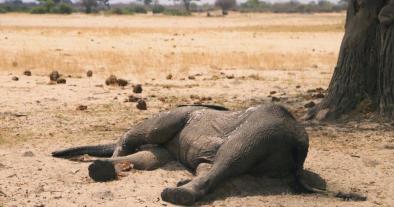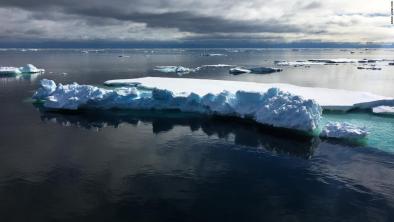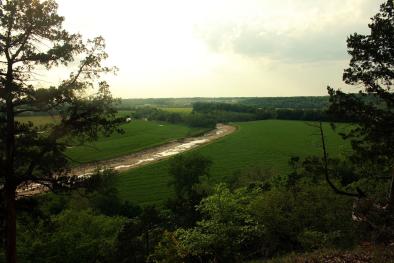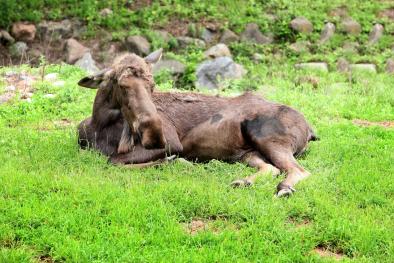
Habitat Shift or Decline
Shifts in climate are changing the geographical range of many plant and animal species, forcing them uphill, poleward, and elsewhere in search of conditions better suited to their survival.
On top of range shifts, animals are being pushed to change their behavior. Many birds, for example, are having to migrate earlier to keep up with earlier springs.
There are organisms that survive and even thrive in response to regional climate change, but these are exceptions to the rule and include invasive species as well as organisms dangerous to human health — like insect disease vectors, parasites and bacteria.[2] For instance, the deer tick's range in North America has expanded, which means the risk area for Lyme disease has expanded as well.
Read More


Climate science at a glance
- Shifts in climate are changing, shrinking and/or eliminating the geographical range of many plant and animal species.[1][2][3][4]
- Global warming forces many species uphill,[5] poleward,[1][3][6] or elsewhere[2][4] in search of suitable habitats.
- Animals are being pushed to change their behaviors in response to climate changes.[7] For example, many birds are having to migrate earlier to keep up with earlier springs.[7][8]
- The phenology (seasonal periodicity and timing of life-cycle events) of species is also changing with the earlier onset of spring and longer growing seasons.[7][8]
- A 2017 study finds that of a sample of 27,600 vertebrate species from various regions on Earth, 32 percent have decreased in population size and range, and that all 177 mammals for which the authors had detailed data have lost 30 percent or more of their geographic ranges.[9]
- Another 2017 study estimates that 47 percent of terrestrial non-flying, non-gliding threatened mammals (out of 873 species) and 23.4 percent of threatened birds (out of 1,272 species) may have already been negatively impacted by climate change in at least part of their distribution.[10]
Background information
Plants and animals are on the move
Global warming is changing the geographical range of many plant and animal species, forcing them uphill and poleward in search of suitable habitats.[1][2][3][4] Other climate change trends, like more frequent droughts or floods in a given region, can alter,[1][2] shrink[9] or eliminate habitat ranges as well.
A series of place-based observations and syntheses of existing data indicate that many plants and animals have experienced range shifts over the past 30 years that approach the magnitude of those inferred for the last 20,000 years (the time of the last glacial maximum).
On top of range shifts, animals are being pushed to change their behavior.[7] For example, many birds are having to migrate earlier to keep up with earlier springs.[7][8]
Barriers and vulnerabilities
Although species attempt to migrate with their corresponding climate zones, manmade obstacles or natural barriers such as coastlines and mountain ranges may block their paths. Species with highly specialized climate or food needs, such as mountain-restricted and polar-restricted species, are particularly vulnerable to climate disruption.[7]
Marine species range shifts
Just as on land, ranges of many marine animals have shifted poleward in recent decades.[1] The pace of these changes can be faster in the sea[1] because of the high mobility of many marine species. The physiology of most marine organisms makes them particularly sensitive to temperature, so they have an especially narrow range of temperatures in which they can survive.[2] Changes have also been observed in ocean productivity, which measures the photosynthetic activity of organisms at the base of the marine food web.[11]
Changes in phenology
Additionally, the phenology (seasonal periodicity and timing of life-cycle events) of species is changing with the earlier onset of spring and longer growing seasons.[7][8] The implications of all these changes for biodiversity, the provision of ecosystems services, and feedbacks on climate are not well understood.[11]
US habitat trends and climate change
- (Hill and Field, 2021): Out West, the changing climate is forcing tree populations toward cooler and wetter areas. Researchers found the shifts toward higher, cooler altitudes were accelerated in Douglas fir and canyon live oak in areas burned by wildfires.
- (Kopec et al. 2017): Among North American and Hawaiian native bee species with sufficient data to assess (1,437), more than half (749) are declining; nearly a quarter (347) are imperiled and at increasing risk of extinction; and climate change is one of their major threats.[12]
- (Mayor et al. 2017) finds that 9 of 48 migrating passerine bird species in North America did not keep pace with rapidly changing green-up over the period 2001–2012. Across all the 48 species, the interval between arrival and green-up increased by over half a day per year.[8]
- (Smithers et al. 2017): The Great Basin treeline for the two dominant Great Basin sub-alpine species, limber pine and Great Basin bristlecone pine, is expanding upslope with a mean vertical elevation shift of 63 feet (19.1 meters) since 1950.[5]
- (Giersch et al. 2016): The probability of occurrence of the meltwater stonefly (Lednia tumana) increased with cold stream temperatures and close proximity to glaciers and permanent snowfields, suggesting climate warming-induced glacier and snow loss imperils the species’ persistence throughout its range.[13]
- (Stephens et al. 2016) produce composite population indices for two groups of breeding bird species across the United States and Europe: those for which climate suitability has been either improving or declining since 1980. The ratio of these composite indices, the climate impact indicator (CII), reflects the divergent fates of species favored or disadvantaged by climate change, and the study finds that the trend in CII is positive and similar in the two regions.[14]
- (Raffa et al. 2008): Recent bark beetle population eruptions have exceeded the frequencies, impacts, and ranges documented during the previous 125 years.[15]
Global habitat trends and climate change
- (Ramírez et al. 2017): Hot spots of marine biodiversity coincide with areas most severely affected by global warming.[16]
- (Ceballos et al. 2017): Of a sample of 27,600 vertebrate species from various regions on Earth, 32 percent have decreased in population size and range. All 177 mammals for which the authors had detailed data have lost 30 percent or more of their geographic ranges.[9]
- (Pacifici et al. 2017) estimate that 47 percent of terrestrial non-flying, non-gliding threatened mammals (out of 873 species) and 23.4 percent of threatened birds (out of 1,272 species) may have already been negatively impacted by climate change in at least part of their distribution.[10]
- (Laloë et al. 2017): Higher incubation temperatures increased the ratio of female to male hatchlings at a globally important loggerhead sea turtle nesting site. As incubation temperatures neared lethal levels, the natural growth rate of the population decreased.[17]
- (Poloczanska et al. 2013) examines a meta-database of 1,735 marine biological responses for which either regional or global climate change was considered as a driver, and finds that the mean rate of species shift was 45 miles (72 kilometers) per decade.[4]
- (Parmesan and Yohe 2003): Global meta-analyses document significant range shifts averaging 3.8 miles (6.1 kilometers) per decade towards the poles.[3]
Africa
- (Rey et al. 2017) observed that, following a particularly dry and hot summer in the semi-arid Kalahari, five of six aardvarks involved in their study and 11 other aardvarks at the study site died.[18]
- (Woodroffe et al. 2017) finds that high ambient temperatures were associated with reduced activity, longer inter‐birth intervals, and poorer pup recruitment in African wild dog (Lycaon pictus) populations.[19]
- (Wato et al. 2017): Incidents of drought have occurred more frequently in Africa over the last 25 years, and prolonged dry periods result in increased adult elephant mortality due to starvation.[20]
- (Sherley et al. 2017): Climate change and industrial fishing have depleted forage fish stocks in the Benguela ecosystem, and juvenile African penguin (Spheniscus demersus) survival is low in populations selecting degraded areas within the system.[21]
Australia
- (Duke et al. 2017) finds that during a period of high temperatures and low precipitation between late 2015 and early 2016, over 7400 ha (18,300 acres), or 6 percent, of mangrove tidal wetland vegetation along 1000 km of the shoreline of Australia’s remote Gulf of Carpentaria died.[22]
Arctic
- (Durner et al. 2017: Westward drift of the sea ice used by adult female polar bears in the Beaufort and Chukchi seas increased between 1987–1998 and 1999–2013, and bears compensated with more eastward movement by spending more time active or increasing their traveling speed (i.e., using more energy).[23]
- (Wilder et al. 2017): Nutritionally stressed adult male polar bears were the most likely to pose threats to human safety in Canada, Greenland, Norway, Russia, and United States from 1870–2014. Increased concern is warranted given that loss of sea ice habitat will likely drive more hungry bears to land near people.[24]
- (Pilfold et al. 2016): Yearly proportions of Beaufort Sea adult female polar bears swimming in 2004–2012 were positively associated with the mean daily rate of open water gain between June–August.[25]
US habitat-climate change attribution studies
- (Steward et al. 2017): Despite an abundance of suitable rocky habitat, climate warming appears to have precipitated the demise of the American pika (Ochotona princeps), a temperature-sensitive small mammal, from a 165-km2 area located within its core habitat in California’s Sierra Nevada mountains.[26]
Global habitat-climate change attribution studies
- (Rosenzweig et al., 2008): In a database of 29,000 data series pertaining to observed impacts on Earth’s natural systems, about 90 percent are linked to global warming. Human-caused climate change has had a significant impact on physical systems, such as glaciers shrinking, permafrost melting, and lakes and rivers warming. Climate change also affected biological systems, such as leaves unfolding and flowers blooming earlier in the spring, birds arriving earlier during migration periods, and plant and animal species moving toward Earth's poles and higher in elevation. In aquatic environments such as oceans, lakes, and rivers, plankton and fish are shifting from cold-adapted to warm-adapted communities.[27]
- (Root et al. 2003): A meta-analysis of information on species and global warming from 143 studies reveals a consistent temperature-related shift, or ‘fingerprint’, in species ranging from molluscs to mammals and from grasses to trees. More than 80 percent of the species that show changes are shifting in the direction expected on the basis of known physiological constraints of species.[28]









